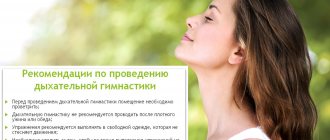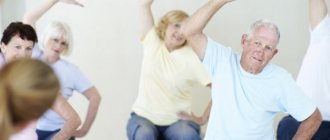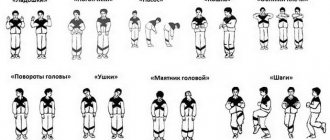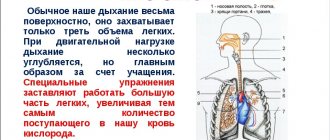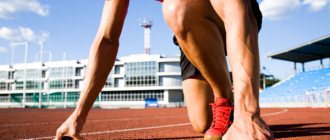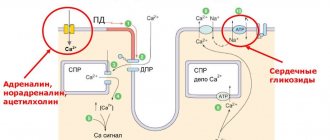Various techniques
In order for therapeutic exercises and gymnastics to help with arrhythmia, you need to select a complex based on the type and stage of the disease according to the recommendations of the attending physician. Thus, when diagnosing atrial fibrillation, excessive loads in general are strictly prohibited, and starting exercises is allowed only in a hospital setting under the direct supervision of a specialist. Other types of pathology are not prohibitions for therapeutic exercise with a properly selected set of exercises.
According to Bubnovsky
Exercises to restore normal heart rhythm according to Bubnovsky’s method include squats involving all the muscles of the legs and buttocks. The main requirement when performing them is to squat while inhaling and stand up while exhaling. At this time, the body distributes blood evenly from the heart muscle throughout the body, which eliminates heart fibrillation.
During such exercises, special attention should be paid to the physical preparation of the leg muscles, placing the maximum amount of load on them if possible. In such cases, performing squats in compliance with the correct exercise technique can replace cycling, running, and walking in terms of the degree of impact on the body.
You should start classes with 5–10 squats in 1 approach in the complete absence of physical training and from 15–20 in the presence of it. The number of approaches in the first stages of such physical education should not exceed three. Over time, you should increase them, as well as the total number of squats.
It is also recommended that Bubnovsky take heart rate measurements before and after exercise and compare the readings with the norm. Thus, it is possible to check the results of the treatment.
According to Strelnikova
The sinus type of arrhythmia, although one of the safest for health, also requires treatment using breathing exercises. In this case, exercises using Strelnikova’s method are especially effective. Exercises allow you to normalize your heart rate, and in the first stages of arrhythmia, cure it completely.
Like other breathing exercises, Strelnikova’s technique is aimed at activating the cardiovascular and circulatory systems and requires regularity and a gradual increase in load. The exercises should be performed in this order:
- Standing straight, take 5 to 8 shallow breaths. Walk a short distance, taking a short breath with each step. It's worth starting with 8 steps.
- Standing with your arms down and your back straight, you need to clench your fists as you inhale and unclench them as you exhale. It is recommended to perform the exercise at least 6 times with a break.
- Standing with your hands on your waist, lower your hands down as you inhale and return them to their place as you exhale. For the first stages of training, it is recommended to perform the exercise 10–12 times with a break.
- Standing straight, with your legs apart at shoulder level, you need to inhale and tilt your body down and spread your arms to the sides. As you exhale, you need to return to the original position. The exercise should be repeated 12–15 times with breaks.
Regular performance of this set of exercises allows you to quickly get rid of a low or high heart rate. But it should be remembered that deterioration in well-being during exercise requires temporary cessation and a reduction in the pace of their implementation in the future.
According to Buteyko
The Buteyko exercise technique for the treatment of arrhythmia is one of the most common and popular methods of getting rid of this pathology. It is based on training the correct breathing rate, which affects the heart rate. This complex includes the following exercises:
- Standing straight, take shallow breaths, hold your breath for 5 seconds and long exhales. In this case, you need to breathe through your nose, and your chest and stomach should remain motionless while inhaling. It is recommended to repeat the exercise 10 times.
- In a standing or sitting position, inhale, gradually filling the diaphragm and chest, then, emptying them in the reverse order, slowly exhale. At least 10 repetitions of the exercise are also required.
- Alternately take 10 full breaths from each nostril. During breaks between them, you should perform a light massage of the nose.
- Pull your stomach in, take a full breath and hold your breath for 5 - 7 seconds, then exhale slowly. It is recommended to repeat the exercise 10 times with a break after each approach for 5 seconds.
- Take 12–15 exhalations and inhalations for 2–3 seconds.
Active breathing exercises using the Buteyko method will help strengthen the whole body as a whole and improve the functioning of the heart in particular.
Physical exercises for cardiac arrhythmia
Physical activity is an important treatment for arrhythmia. But it must be correct and moderate. In addition, regularity is important. In addition to special exercise therapy for arrhythmia, the following sports may be useful as prescribed by a doctor:
- Swimming. Helps maintain muscle tone.
- Walking in place.
- Walking outside.
- Slow running.
- A ride on the bicycle. Helps to engage a large number of muscle groups and restore the correct breathing rhythm.
In the first weeks after discharge from the hospital, the pace of simple walking should be no more than 100 steps per minute. To monitor this, you can use a special pedometer. Over time, the number of steps increases to 150 per minute.
You can start running after 2-3 months. At first, the distance should be no more than 300 meters. After a week it can be increased by another 100 meters. The pace should be slow.
Breathing exercises
If arrhythmia occurs after exercise, it is recommended to perform breathing exercises. Physical therapy not only provides disease prevention, but also reduces the risk of complications. The technique includes the following:
- The patient does a half-squat and extends one arm to the side. Pinch one nostril with your left and inhale slowly. Then they change and do the same. The frequency of repetitions is set by the doctor depending on the presence of tachycardia, high blood pressure, fibrillation and other reasons. Such gymnastics is not recommended for a small child.
- Then the patient makes breathing movements while sitting on a chair. Physical exercises are not indicated at this stage. With one hand, you need to pinch one nostril to the bridge of your nose and slowly inhale air. They try to exhale quickly. After this, do the same with the other nostril.
- Slowly take in a deep breath of air and gradually exhale.
- At the last stage, repeat the breathing movements from the third point. At the same time, they try to stretch their lips “into a tube.”
The advantage of properly performing gymnastics is the enrichment of oxygen in the blood and tissues of the whole body. The patient independently controls breathing and movements of the diaphragm while doing the exercise.
Exercise therapy for arrhythmia
Treatment of arrhythmia with physical exercises involves a whole complex of special gymnasts. The doctor must create an individual program based on the severity and extent of the disease, the nature of its course, and the recovery time that the body needs. The load on the body must be strictly dosed.
The exercises differ in the following ways:
- Anatomically. The complex can be developed for individual muscle groups.
- By independence. Exercises can be passive, prescribed for disorders of motor activity, as well as active, which the patient can perform independently.
To achieve results, exercises are performed to strengthen certain muscle groups. Over time, muscle tissue adapts to physical activity, and disturbances caused by arrhythmia are gradually corrected.
Exercise therapy is also prescribed for atrial fibrillation. However, you should not perform exercises on your own, as they may worsen the condition. Gymnastics should be carried out under the supervision of a doctor.
Therapeutic exercise helps to increase the effectiveness of drug therapy many times over, restore normal motor activity, heart rate, and blood circulation. However, it is important that the exercises are appropriate to the patient's medical history.
Exercise therapy in the treatment of arrhythmia
Exercises in the exercise therapy complex, intended for patients with arrhythmia, have not only a healing purpose. This is a gymnastics complex with a strictly dosed load for a specific patient, which takes into account the state of his health, the severity of the disease and the period of development of the disease.
Example exercises in a lying position:
- Flexion and extension of the legs at the ankle joints.
- Flexion and extension of fingers.
- Abduction of arms bent at the elbows. Move your elbows to the sides - inhale, extend your arms along your body - exhale.
- Inhale, extend your arms along your body, palms up. Exhale – raise your arms and reach your knees with your palms, raising your head and tensing.
- Alternately sliding your feet along the bed without lifting them from its surface. Breathing is smooth, without tension.
- Turns with knees bent at the legs, now to the right, now to the left. Breathing is smooth and spontaneous.
- Alternately abducting the right arms and legs to the side, then the left. At the same time, turn your head in the direction of abduction of the limbs.
- Alternately bending and straightening your legs at the knees.
- Lowering and raising your arms up: on inhalation - up, on exhalation - down.
Sitting on a chair:
- Press against the back of the chair. Hands on knees. Taking a deep breath, raise your arms, bent at the elbows to the shoulders. As you exhale, return to the original position.
- Rolling from heel to toe and synchronously clenching and unclenching your fingers.
- Inhaling, raise your arms up, exhaling, lower them down.
- Sliding your feet along the floor without lifting them from its surface.
- Sitting on the edge of a chair and inhaling, move your right arm and left leg to the sides. As you exhale, lower your arm and bend your leg at the knee. Do the same on the other side.
- Hands along the body, alternately lift the left, then the right shoulder. Breathing is smooth and relaxed.
- Inhaling, spread your arms to the sides, exhaling, use your hands to pull the leg bent at the knee towards your stomach and return to the starting position. Do the same for the other leg.
- Sitting on the edge of a chair, place your hands on your belt and take a deep breath. As you exhale, pull your elbows and shoulders inward.
Starting position standing:
- As you inhale, stretch and clasp your hands. As you exhale, lower your arms.
- Tilt the body to the sides while simultaneously abducting the legs in the same direction. Hands raised up.
- Bend your elbows at chest level and spring your arms back.
- Smooth body rotation left and right.
- Inhale with your arms raised up. Lean forward and reach your knees with your hands - exhale.
- Swing your legs forward and backward. Breathing is voluntary.
- Inhale, squat with your arms extended forward and exhale.
Perform all exercises no more than 10 times, monitor your well-being, breathing, and heart rate.
Gymnastic exercises
Let's consider the most acceptable set of exercises:
- Walk in place for 2-3 minutes. The pace is measured, the movements of the upper limbs are arbitrary. Breathing through the nose.
- Take a standing position. When raising your arms up, take a deep breath, when lowering, exhale. Repeat the exercise 5-10 times. After some time, the cycle should be 30-50 times, but you need to build up to this gradually.
- Spread your arms to the sides. As you turn your body to the left, take a deep breath. When you turn your body to the right, exhale.
- Place your hands on your belt, as if to rest. Next, begin circular movements of the pelvis. Ten times in one direction, then the same amount in the other. Gradually increase the number of spins to a minimum of 30, maximum of 50 times.
- Perform circular movements with each hand, first forward, then backward. Initially, 10-15 times are enough, but subsequently you need to increase the number of movements to 50.
- Walk in place for 3 minutes, raising your knees as high as possible.
- You can finish your exercise by walking at a moderate pace. Duration about 5 minutes.
Arrhythmia - breathing and physical exercises as treatment (Buteyko method, yoga and others)
Charging, developed according to the Buteyko method, is used not only in Russia, but also actively abroad. At first it was prescribed for the treatment of bronchial asthma. A little later, people with heart diseases could also do it. Most often these were patients with arrhythmia.
It is based on working with the diaphragm. Due to a special approach to the respiratory system, it is possible to normalize the gas composition. Buteyko established that tissues vitally need not only oxygen, but also carbon dioxide. The patient must constantly practice the technique proposed by him.
Proper breathing during cardiac arrhythmia will help not only improve the quality of life, but also reduce the severity of symptoms of the disease. Any teenager or elderly person can easily practice according to Buteyko’s recommendations. The training complex includes the following exercises:
- Inhalation is done through the nose. It must be done gradually (about 4-5 seconds). The stomach should not be involved. Then, within a few seconds, exhale. It is recommended to do 10 approaches.
- Next, you need to inhale for not 5, but 9 seconds. The patient is in a calm state, gradually filling the diaphragm and chest with air. When the goal is achieved, you need to exhale. After this there is a pause for rest - 5 seconds. The respiratory complex already includes 11 approaches.
- When the patient is not doing the exercise, he self-massages the bridge of his nose.
- Then the breathing movements are again through the nose, but alternately - first through one nostril, and then through the second. Each of them is given 9-10 approaches. During the procedure, the patient monitors his heartbeat and pulse. If unpleasant sensations appear, it is recommended to interrupt physical training and deal with the cause.
- Gradually inhale to the entire possible depth of the chest. Movements should not bring discomfort. You need to pull in your stomach and pause for about 6-8 seconds.
- Next, 12 breaths are required over the course of 1 minute.
- At the last stage, normal breathing is restored.
httpv://www.youtube.com/watch?v=embed/CbbeUz4EnHc
Such physical activity for cardiac arrhythmia is contraindicated in children under 4 years of age and persons with developmental disabilities. It is recommended to postpone physical education for a while in case of viral diseases or exacerbation of pathology. If the patient has chronic tonsillitis, then the question of using the technique as one of the means of treatment is decided individually.
Stretching exercises
Stretching (stretching) and some yoga asanas are designed to make the body more flexible, relax muscles and improve blood circulation. Before training, you should warm up (under a warm shower). Exercises are done smoothly, avoiding sudden dynamics.
When performing this, patients adhere to the following rules:
- exercise at least an hour and a half after eating;
- if there is pain in the heart, shortness of breath, or dizziness, immediately stop exercising and take validol or nitroglycerin;
- control the pulse.
The complex is performed standing and sitting in the following sequence to restore proper breathing during cardiac arrhythmia:
- hand lowered along the body, the other pull the head to the shoulder, repeat on each side;
- feet shoulder-width apart, one hand on the waist, the other raised, tilt the body to the side behind the hand;
- do ten spring bends to each leg in turn;
- sit with your legs wide apart, tilt your body forward towards each leg in turn.
Exercises for physical therapy in the illustration below:
Charging as a method of treatment
Breathing exercises for arrhythmia have a beneficial effect on the cardiovascular system. During inhalation, the bronchi enlarge and the cardiac ventricles discharge blood, which passes from the right ventricle into the pulmonary vein, and from the left into the aorta. As you exhale, the bronchi become smaller and the atria take in blood.
If the heart rate is abnormal, the patient should start with exercise every morning. It restores the rhythm of the heartbeat and strengthens the heart vessels. You can do the following complex at home:
- Walking in place. Breathing through the nose. Swing your arms to the sides as you walk. Perform for 3–5 minutes.
- Turns. Starting position – standing. Place your feet shoulder-width apart. Hands at waist level. Turn your torso left and right. The number of repetitions is 10–12 times.
- Tilts. The starting position is still the same. Stretch your arms along your body. Exhale and bend to the left, while inhaling, return to the i.p. Then repeat the bend in the other direction. The number of repetitions is 10–15 times.
- Circular movements. Hands on waist. Make 10-12 movements of the pelvis in each direction.
- Mahi. Raise your arms above your head. Swing your arms forward and back in 10-12 circles.
You need to do exercises before breakfast or 2.5 hours after it. If the exercises are easy, then you can increase the number of repetitions up to 30 times. You can complete the exercise by walking in place.
Yoga can improve the quality of life of patients with irregular heart rate. Physical exercise with proper breathing restores heart rhythm. The following asanas will help you get rid of arrhythmia:
- Lotus pose. Place your palms on your heels. Pull your stomach in and lean forward. Hold this position for 1–3 seconds. Then exhale and take an i.p.
- I.p. - lying on your back. Spread your legs wide enough so that you can grab your ankles with your hands. As you exhale, accept and. P.
- I. p. - lying on your back. Inhale and lift your head, elbows and legs off the floor. As you exhale, lower yourself to the floor.
Yoga, like any sport, is not beneficial for everyone. Yoga asanas are contraindicated for:
- mental illness;
- inguinal hernias;
- paroxysmal tachycardia;
- increased blood pressure;
- blood diseases;
- pregnancy;
- arthrosis;
- exacerbation of chronic diseases.
» alt=»»>
httpv://www.youtube.com/watch?v=embed/BxFqMO3B6C4
sosudoff.ru
Particular attention should be paid to exercise during cardiac arrhythmia. It should be regular, preferably done in the morning and evening
Exercise will help not only restore heart rhythms, but also strengthen the blood vessels of the heart.
Place your feet shoulder-width apart, arms lengthwise. While inhaling, rise onto your toes, raising your arms simultaneously. Exhaling, you need to return to the starting position. Repeat 11-12 times. Do six approaches every day with an interval of 5-7 seconds.
In the initial standing position, your arms should be evenly raised at shoulder level. As you inhale, bend your arms, and as you exhale, straighten them. Do the exercise 12-14 times with a break of 5 seconds.
Hands on the belt, feet shoulder-width apart. Perform body turns: while exhaling - in one direction, while inhaling - in the other. Do 9-12 times. In the same way, you can perform turns by spreading your arms to the sides.
In a standing position, while exhaling, bend forward, and while exhaling, straighten up.
This is a big burden, especially in severe forms of the disease. It is necessary to limit yourself to standard squats 8-11 times with a break of a minute.
You need to finish the exercise by walking slowly in place for 2-3 minutes.
All physical exercises for cardiac arrhythmia should not cause shortness of breath or discomfort. After three months of regular exercise, you can add exercises with 1-kg dumbbells.
After six months of training, it is necessary to gradually begin hardening, i.e. dousing with water.
It is better to start in the warm season. The water should not be icy; its temperature should be lowered gradually so as not to cause stress in the body and not cause even greater heart problems.
Breathing exercises for cardiac arrhythmia
Breathing exercises are prescribed to patients to restore oxygen supply to the brain, normalize heart rate and prevent hypoxia.
The exercises are performed every day - in the morning before breakfast and at night.
The complex includes the following exercises:
- Warm up. Stand up and take a few small, quick breaths in and out. And at the same time, begin to slowly walk in place, taking each step as you inhale.
- The exercise is performed in a standing position. Lower your hands down, while inhaling sharply, quickly clench your palms into fists as far as you can, and while exhaling, unclench them. Make six turns with breaks of 25 seconds.
- Place your arms along your body, spread your legs shoulder-width apart. Exhale slowly while leaning forward and stretching your arms. As you exhale, straighten up and lower your arms. Do no more than 13 repetitions, then rest.
- Stand up, clench your two hands into a fist, place them on your waist. Unclench your fists and lower your arms while inhaling sharply. As you exhale, return to the starting position.
The number of breaths needs to be increased every day.
If you feel dizzy, stop exercising. You cannot overload the body. Start with a small number of repetitions and gradually increase it. Breathing exercises can be performed not only for arrhythmia, but also for prevention. They have a beneficial effect on the functioning of all organs and systems, helping to saturate them with oxygen.
Gymnastics according to Buteyko for arrhythmia, as an alternative method of treating pathology
- constant stress and nervous breakdowns;
- malfunction of the central nervous system - skull injury, circulatory disorders, brain tumor;
- it can also be caused by a violation of the biochemical composition of the blood;
- poisoning with various substances (toxic or drugs);
- myocardial disease.
The appearance of arrhythmia can be facilitated by constant constipation, eating large amounts of food, and clothing that restricts movement. Diabetics are especially at risk for heart disease when they are obese or have low/high blood pressure.
What symptoms indicate the development of arrhythmia?
As we have already defined above, arrhythmia has a number of types of diseases that are distinguished by dissimilar symptoms.
For example, a malfunction in the body system with sinus tachycardia is accompanied by heart contractions at a frequency of 90 beats per minute. This figure may be higher. At the same time, a person who has such a cardiac pathology most often suffers from shortness of breath and palpitations. He is constantly weak and broken, and with little physical activity he gets tired quickly.
If a person is dealing with paroxysmal tachycardia, the heart rate will reach up to 240 beats. An attack can last from a minute to 2-3 days and is accompanied by “jumping out” of the heart, frequent urination, diarrhea, fainting, etc.
With extrasystole, which is characterized by sharp shocks with fading, the “core” does not feel discomfort. In addition, the disease does not need to be treated, because it does not pose a threat to human life. Just like sinus arrhythmia, which most often occurs in young people and expectant mothers. But for prevention purposes, it is recommended to do therapeutic exercises for arrhythmia.
A more serious cardiac pathology in this regard is atrial fibrillation, which is accompanied by pain and trembling in the chest. The peculiarity of this disease is that the atria do not contract completely, but the ventricles do so at approximately 100 to 150 beats per minute. Pathological abnormalities can even accompany heart defects.
Often these heart diseases change the lifestyle of a person who tries to adapt to the conditions as much as possible in order to feel more comfortable in society. This is why there are many programs and methods aimed at treating diseases in heart patients. The Buteyko method is recognized as one of the most effective.
Buteyko method: treating arrhythmia with gymnastics
Gymnastics according to Buteyko for arrhythmia has become popular and has acquired medical practice not only in Russia, but also in France and Canada, the USA and Austria, Germany and the UK, and Bulgaria.
This method involves training in proper breathing. Initially, the method of Volitional Elimination of Deep Breathing was developed for the treatment of bronchial asthma. But over time, the author of the technique realized that not only this disease can be treated with the help of the developed gymnastics.
The essence of therapeutic exercises for arrhythmia using the Buteyko method is to relax the diaphragm, with the help of which we try to reduce the depth of breathing.
A set of exercises to develop proper breathing:
- When performing gymnastics, you need to take a small breath through your nose so that your stomach and chest remain motionless. Then hold your breath for 5 seconds. and exhale slowly and continuously. It should last about 4-5 seconds. We pause for the same amount of time and repeat the exercise 10 times.
- We combine the diaphragm and chest breathing. We relax and take a full breath for 7 and a half seconds, first filling the diaphragm and then the chest. Then exhale slowly, starting from the lungs. 5 seconds pause. Repeat 10 times.
- During pauses, we do a relaxing nasal massage.
- We perform 10 full breaths, first with the left side of the nose, and then with the right.
- With a full inhalation and a retracted stomach, hold your breath for 7 and a half seconds. Slow down the exhalation. We rest for 5 seconds. We repeat the exercise 10 times.
- We perform 12 inhalations and exhalations. As a rule, one breath lasts about 2 seconds. Do the exercise for a minute.
- We do very rare level breathing.
Buteyko claims that this exercise helps strengthen the cardiovascular system and prevents the emergence of new “heart” diseases.
Contraindications for treatment using the Buteyko method
There are not many contraindications for the use of this exercise, so most patients with arrhythmia can use it.
Gymnastics for arrhythmia is prohibited for people with the following pathologies:
- mental deviations, when a person cannot understand the essence and carry out the process;
- deviations with severe bleeding;
- chronic tonsillitis;
- infectious diseases.
httpv://www.youtube.com/watch?v=embed/wEPxLzWN7lA
httpv://www.youtube.com/watch?v=embed/CbbeUz4EnHc
What symptoms indicate the development of arrhythmia?
As mentioned a little earlier, arrhythmia accompanies a number of diseases that are characterized by completely different symptoms. You can take as an example deviations in the body if sinus tachycardia is observed.
It is accompanied by frequent contractions of the heart, and the pulse rate increases to 90 or higher beats per minute. With this disease, the patient may experience shortness of breath and rapid heartbeat, a feeling of weakness and weakness, rapid fatigue and exhaustion.
If the patient has paroxysmal tachycardia, the pulse rate reaches 240 beats per minute. Attacks are observed with a frequency of 1 minute, which can last up to 2-3 days (there will be a so-called jumping out of the heart).
The main symptoms of the disease are diarrhea, frequent urination, fainting and other signs may also be observed. Extrasystole is characterized by frequent and impulsive tremors with slight fading (there is no feeling of discomfort).
This type of disease does not need to be treated; it is safe for human life and does not have serious consequences. Sinus arrhythmia with similar symptoms can be observed in young expectant mothers.
For prevention, experts recommend performing gymnastic exercises so that diseases do not progress and interfere with life.
How to cauterize the heart for arrhythmia
Of all forms, atrial fibrillation is considered the most severe, which is characterized by pain and trembling in the chest area. In atrial fibrillation, the atrium does not contract completely. The ventricles produce from 100 to 150 beats per minute, even heart defects can be observed.
Diseases of this kind most often radically change the life of the patient, who is trying to adapt to certain conditions of society. For this purpose, there are a number of programs and techniques for the treatment of heart-related diseases. Experts say that Buteyko gymnastics can be considered one of the most popular and effective methods.
Rules for performing exercises
Both at home and in the hospital, the patient must adhere to the following rules when engaging in exercise therapy:
If the patient belongs to the first group, then the duration of his training can be 30-45 minutes. For the second group, you cannot load all the muscles in one workout with a duration of no more than a quarter of an hour. After breathing exercises, be sure to rest. Constantly monitor your pulse, the permissible deviation is 10% from the norm. For the third group, exercises are very limited, as they can provoke thromboembolism
It is permissible to train individual muscle groups with partial amplitudes, and the training should not take more than 10 minutes. If your health worsens, for example, patients with hypertension may experience shortness of breath or heart pain, classes should be stopped immediately. It doesn’t matter whether a child or an adult has suffered from coronary artery disease, the doctor will select all the exercises while still in the hospital and give recommendations regarding home exercises.
What exercises are prohibited for arrhythmia?
Not all activity will be beneficial for arrhythmia. For example, strength exercises with weights are prohibited. They can have a negative effect on the heart muscle.
Isometric exercises are also not recommended. With intense work of muscle tissue, blood circulation improves, but there may be a lack of oxygen in the heart area.
The use of barbells, dumbbells, expanders, and strength training equipment is prohibited.
For arrhythmia, exercises that involve holding your breath and staying in one position for a long time are not recommended. It is recommended to refrain from yoga and exercises to pump up the abdominal muscles.
Strength training involves sudden movements during exercise, which can cause deterioration in well-being, dizziness, and heart pain. Any load for arrhythmia should be moderate and dosed.
Useful exercises to strengthen the myocardium
In diseases of the cardiovascular system, it is the loads that can increase the resistance of the myocardium to oxygen starvation that bring benefits. These include walking, running, swimming, dancing. Breathing exercises have a similar effect on the heart muscle. Methods for carrying it out may differ, but the most important rule is that the exercises must be performed at an individual, comfortable level.
First aid for arrhythmia
The method of restoring heart rhythm using breathing is based on the fact that a measured rhythm of inhalation and exhalation, which a person can control, normalizes the rhythm of contractions of the heart muscle. Therefore, any option with counting the duration of respiratory movements helps with arrhythmia.
To do this, you can inhale for 2 - 3 counts and exhale for 4 - 6 counts. In this case, you need to be in a sitting position with a straight back. It is recommended to gradually stretch your inhalations and exhalations, focusing on your sensations.
After mastering this exercise, the following type of pulmonary exercises is recommended to prevent attacks:
- Left hand behind back.
- The right hand is located near the face.
- Close your right nostril with your right thumb.
- Inhale through the left nostril.
- Close the left nostril with your ring finger and exhale through the right nostril.
After 8 - 10 breathing cycles, you need to change hands. The duration of the first lesson should not exceed 2 - 3 minutes, then you can slowly increase it. The duration of inhalations and exhalations is determined by comfortable sensations.
For cardiac aneurysm
The use of any load for training, even breathing, with an aortic or cerebral aneurysm, is possible only after consulting a doctor, since stress can provoke intense internal bleeding and death.
If there is a small and stable aneurysm or an operation has been performed to remove this vascular defect, then the doctor may allow you to do gymnastics, including breathing. In this case, any low-intensity and slow movements with simultaneous inhalation and exhalation are indicated:
- spread your arms to the sides - inhale, hug yourself by the shoulders with them - exhale;
- with the pelvis stationary, turn the chest to the right - inhale, return to the starting position - exhale;
- in a position lying on your back, inhale with your stomach for 2 counts, raising the abdominal wall; for 4 counts, exhale, drawing in your stomach.
Watch the video about doing exercises for the heart and their benefits:
httpv://www.youtube.com/watch?v=embed/aNUu4Fhvkts
After operation
From the second day, with an uncomplicated postoperative course, patients begin breathing exercises under the guidance of a doctor to prevent congestion in the lungs. To do this, it is recommended to spend 5-6 times a day for 5 minutes:
- exhale through closed lips (movements like when blowing out a candle);
- inflating balloons or rubber toys;
- exhaling air through a straw into a glass of water.
After 5-6 days it is allowed to sit on the bed and walk within the ward. At this time, breathing exercises are carried out in an expanded mode. Recommended:
- deep belly breathing with accentuated exhalation,
- smooth stretching of the exhalation length,
- inhale for 3 counts and exhale, and then 2 more short exhalations.
With tachycardia
To slow down your heart rate you need maximum relaxation. This can be achieved by changing the ratio of the duration of inhalation and exhalation, as well as by pausing after exhalation. In the first lessons, the ratio of these phases is 3:5:2.
Every day they are increased by 1 count, if discomfort appears, they are stopped until a stable result is obtained, and then you can continue to stretch each breathing movement. If at first it is difficult to breathe like this, then after 3-4 cycles they return to normal breathing; after its restoration, it is recommended to extend the lesson.
To improve blood vessels
To normalize vascular tone and increase performance, the following exercise is performed: after a normal (non-forced) inhalation, you need to exhale sharply and briefly, while drawing in your stomach as you exhale. This is followed by a passive inhalation and a sharp exhalation.
Do 10 cycles of the right nostril with the left one closed, change sides, also take 10 inhalations and exhalations, then with both nostrils 15 times.
Need for movement
This is how a person is designed - to be healthy, he must be physically active. Roughly, you can compare the body to a car - when buying a car, it is better to take an old one, but which drives regularly, than a new one, which has stood in the yard of the house for several years and has never started. Therefore, even if a person is sick, even if he has difficulty getting out of bed, he needs movement. The only question is in doses - the patient needs to recover and return to his former life, and not harm himself with excessive zeal.
Not only the functioning of the body depends on movement, but also mood, the ability to work mentally, movement also distracts from difficult thoughts about illness, thus the future life comes to the fore, and not thoughts about sad prospects. People with a diseased heart and blood vessels need aerobic exercises, that is, those that force them to move with free breathing, without static stress and temporary stoppage of lung function.
Loads should be every day and gradually increase. First, you can do exercises in a sitting position, walk slowly, then complicate the set of exercises. There is no point in rushing - with daily effort, a person can feel completely healthy after many months, and possibly several years. To determine the condition of the heart, a cardiologist conducts special tests, diagnostic studies with different types of loads and determines the pace of exercise. In rare cases, exercise is not allowed at all until the cardiac condition normalizes.
Arrhythmia and acceptable physical activity
Most often, with this disease, moderate stress on the body is recommended. Training should be daily. The intensity of classes is increased gradually. At the initial stage, elementary exercises are used: moderate walking, tasks on a chair in a sitting position. The effect of such physical training is not immediately visible; results can be achieved only after several months, or even years. It all depends on the individual characteristics of the body and the regularity of exercise.
Heart rhythm disturbances
Daily walks
Regular walks in the fresh air are very useful, especially for patients with arrhythmia. It is recommended to start with short distances and gradually increase the distance. Taking into account physical health, you need to decide on the pace of walking. Be sure to take your heart rate monitor on your walks. This will allow you to monitor your heart rate. If the device readings are high, you need to slow down the pace or take a break by stopping and resting.
Exercises in the morning
Almost all patients with arrhythmia are recommended to do a morning warm-up. The intensity of the load is determined by the doctor, taking into account age indicators, the severity of the disease, the individual characteristics of the patient, and the presence of other diseases. Charging time is at least 15 minutes. The first classes begin with light exercises, choosing a slow or medium pace. Loads are increased gradually.
Other physical activities
Often, for arrhythmia, minor cardio exercises in the form of swimming and cycling are prescribed. Such training is very useful, but you still need to follow the rules:
classes should be clearly limited in time; it is necessary to monitor the general condition; It is important to check your pulse during training.
Physical therapy for heart pathologies may include aerobics and walking. The exception is exercises with breath holding.
Physical exercises for cardiac arrhythmia
Exercises for cardiac arrhythmia: benefits
Anaerobic exercise helps maintain muscle tone and restores normal functioning of the heart muscle. Breathing exercises for cardiac arrhythmia are the basis for the treatment and prevention of attacks. It helps patients restore their breathing rhythm and normalize blood circulation.
For heart pathologies, exercises are prescribed to normalize the functioning of the entire cardiovascular system. However, in case of arrhythmia, the complex must be selected so as to prevent overvoltage. Exercises are selected taking into account all the characteristics of the disease and are done under the supervision of a specialist. It is important to strictly follow all the doctor’s recommendations and not violate the sequence of exercises.
Gymnastics, which is indicated for arrhythmia, does not involve high loads. It helps improve blood circulation and heart rate, charges the body with vigor and energy.
Contraindications
Therapeutic exercises for cardiac arrhythmia are contraindicated in the following cases:
- if the heart rhythm is excessively disturbed, such a disturbance often manifests itself after a myocardial infarction; more specific symptoms include paroxysmal tachycardia with frequent regular attacks, atrial fibrillation, which worries constantly, in a chronic form);
- attacks of angina pectoris and abnormal heart rhythm, which manifest themselves during physical effort and are formed as a result of coronary heart disease, problems are investigated using the Holter monitoring method;
if the heart vessels do not allow enough blood to pass through for active movement;- if insufficient blood circulation is caused by heart defects, both congenital and acquired;
- if the degree of heart failure is second or third, with the first it is quite possible to exercise, taking into account your capabilities;
- there are renal disorders that do not allow accelerating metabolism through movement, heavy loads are contraindicated in case of serious liver diseases;
- severe problems in the functioning of the endocrine system, for example, the decompensation stage of type 1 diabetes mellitus;
- if high blood pressure is observed during hypertension - above 160 to 90, you cannot exercise until the situation normalizes, especially while taking antihypertensive drugs;
- aortic or cardiac aneurysm, if there is a threat of rupture;
- inflammation of the walls of the leg veins, which is accompanied by the formation of blood clots (thrombophlebitis).
Arrhythmia may not forgive isometric exercises (movements under tension with resistance), as well as exercises with dumbbells, barbells and other weights. With such exercises, blood pressure increases, and oxygen starvation of the heart muscle also occurs, because the muscle mass that is being trained begins to take on blood, oxygen and nutrients. Also, you should not pump up your abs; under no circumstances do yoga, which is too harmful for the heart due to holding your breath.
There are other obstacles to practicing therapeutic exercises, but they are studied by the attending physician based on studies of functional tests, as well as patient complaints.
Breathing exercises and their effect on the heart
Breathing exercises for diagnosed cardiac arrhythmia contribute not only to the restoration of heart rhythm, but also to the improvement of the entire body due to its saturation with oxygen. This happens due to the fact that at the moment of inhalation, the bronchi expand, and the heart ventricles eject blood: the right atrium into the pulmonary veins, the left atrium into the aorta. At the moment of exhalation, blood is actively absorbed by both atria, which normalizes the performance of the heart muscle.
One of the effective methods of treating arrhythmia through breathing exercises is to perform the following list of exercises:
- Perform half squats (if you are in good health - full squats) - from 10 to 20 times.
- Extend your right hand to the side, while with your left you need to pinch your left nostril and take a slow breath.
- Repeat the steps, changing your right hand to your left.
- Sit on a chair and repeat the previous exercise (steps 2 – 3).
- Take 3 to 4 slow, full inhalations and exhalations.
- Repeat the set of exercises with inhalations and exhalations, while stretching your lips, as if pronouncing the letter “u”.
Sports for tachycardia
The following sports are shown:
- Walking in the fresh air at a calm pace, and gradually increasing the training time. It is important to choose a suitable place for walking - a forested area, a square far from highways, etc. Walking along a roadway with heavy traffic can be harmful. If you can’t walk a lot in nature, you can walk on a treadmill, stepper or orbiter at home with an open window, on the veranda or balcony.
- Cycling at a relaxed pace.
- Swimming in a pool or natural body of water, if you feel confident on the water, that is, a stressful situation is basically impossible.
- Dancing at a relaxed pace is good if it is enjoyable.
Whatever the causes of tachycardia, adequate physical activity and special physical therapy are simply necessary. However, both must be agreed with the doctor. Training is carried out without overexertion, at an easy pace and in a feasible volume. Breathing exercises are also shown and very useful.
Tachycardia is a pathology in which the number of heart contractions (HR) increases relative to the norm - 60-80 beats per minute.
3 years ago, 03/30/2017
Tachycardia is a pathology in which the number of heart contractions (HR) increases relative to the norm - 60-80 beats per minute.
An attack of tachycardia can be a completely physiological phenomenon, for example, after active physical exertion. In this case, it goes away on its own and does not require any intervention, but pathological forms must be treated under medical supervision.
Usually the attack begins suddenly, the contraction of the heart accelerates (up to 120-150 beats per minute), weakness, stabbing pain in the heart, and a feeling of fear may occur. Provoking factors can be stress, large meals, drinking alcohol or caffeine, an allergic reaction, bloating, hot flashes during menopause in women.
Execution Rules
You can train your heart during tachycardia using breathing exercises. To begin with, it is recommended to choose a secluded, quiet place. Classes must be conducted indoors, where it is not stuffy, or directly on the street. You need to take short breaks to resume breathing. Next, you need to close one nostril with your index finger, take a strong breath, then exhale. You can carry out the exercise for 2-3 minutes. Such training is useful not only for prevention, but also during the attack itself, to stop it.
You can stop an attack of tachycardia using breathing exercises. If the pulse is 120 beats per minute for a long time, then you will need to call a doctor. The main thing to do before the doctors arrive is to calm down and distance yourself from negative thoughts. Breathing exercises for tachycardia consist of the following stages:
- warm-up;
- main part;
- final exercises.
You can reduce a sharp and increased heartbeat using special techniques:
Exercises aimed at training the diaphragm:
- Inhale through your nose, stop breathing, and exhale. Repeat 10 times.
- Inhale, filling the diaphragm and chest with air, gradually exhale, do 11 repetitions.
- Massage the bridge of your nose during breaks.
- Taking a deep breath, draw in your stomach and hold your breath for 8 seconds.
- Take 12 breaths for 60 seconds.
Return to contents
This type of training is best done in the morning, before breakfast. Physical activity is recommended if there is a problem with the heart, for example, you can take note of the following:
- Bend forward and back. When bending, your arms should be at chest level.
- Do 5-7 lunges, squats, raise your arms as you inhale, lower them as you exhale.
- Tilt your head in different directions and monitor your breathing.
- Feet shoulder width apart. Bend over, spread your arms to the sides, exhale, return to the starting position. Repeat 12 times, taking short breaks.
Return to contents
Training with this gymnastics will help with arrhythmia and tachycardia:
- Get into a position with your feet shoulder-width apart. Lower your hands down and relax, shaking them a little. Then you need to bend them at the elbows, lift them and pull them back sharply. Then rest for 3-5 minutes.
- While standing, raise your legs one by one.
- Spreading your arms to the sides, raise them with your palms up, bend back, and inhale slowly. Bend forward and exhale.
- Stand straight, raise your arms at chest level, bending them slightly at the elbows. While inhaling, the chest is pushed forward; exhaling, return to the starting position.
- Spread your arms to the sides and make circular movements.
If, while doing gymnastics, your heart rate increases, it is better to reduce the pace and time of training.
When choosing a set of special exercises, you need to coordinate them with your doctor. You should not overdo it with physical activity; it is better to give preference to anaerobic exercises. Breathing exercises are performed to calm and relieve an attack. To normalize the heartbeat, it is enough to use exercise therapy 1-2 times a day when diagnosed with tachycardia, as well as for its prevention.
Attacks of tachycardia occur against the background of an uncontrollable increase in heart rate, which is accompanied by a feeling of powerlessness and fear. Improper physical activity will only intensify alarming symptoms, but competent physical therapy (PT) will help normalize the condition, as well as prevent further attacks.
How to stop an attack of tachycardia
Special exercises and techniques can help stop an attack of tachycardia at its first signs.
- Take a deep breath and hold your breath, while trying to push the air down.
- Breathe deeply for 5-10 minutes: take a deep breath and exhale slowly (3 times longer).
- Press your fingers firmly on your eyeballs (until it hurts) for 10 seconds, then release. Continue this action for several minutes.
- Fill a basin with ice water and immerse your face in it for a few seconds. You can simply wash your face with cold water. The temperature change should cause your heart rate to drop.
- Sometimes a strong cough or artificially induced vomiting helps stop the attack.
If the condition does not improve and the pulse exceeds 120 beats per minute, immediately seek medical help.
